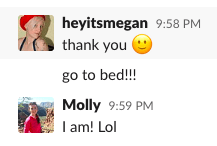Working remotely as a freelancer or solopreneur is one thing.
But when you’re responsible for a whole team of people ALSO working remotely, there are some really important systems and strategies to put in place so that you can:
- Protect your own flexibility
- Stay productive and on top of deadlines
- Keep your team happy and motivated
- Not go insane
Here’s a breakdown of what I’ve found to be some of the most helpful and game-changing tactics for keeping my team productive and content.
Communication!!!
My team covers A LOT of time zones, with the biggest gap being +9 hours.
That in itself can be a challenge because we aren’t always working at the same time.
Having “face time” is really important for us since email and direct messaging aren’t always the best “discussion” tools.
So we have a standing team meeting every Tuesday @ 8:30am PST // 5:30pm CET.
This is also time that we use to chat, catch up on each other’s recent adventures (or misadventures), and connect as people.
I can’t stress the importance of this enough.
You’ve got to treat people like people (not machines) if you want everyone to do their best work (and have a good time doing it).
Spoiler alert: no one does their “best work” if they are having a shitty time.
Aside from that, our primary mode of communication is Slack.
We keep a channel for each client where we discuss projects we are working on, share files, etc.
Slack is another place we get to stay connected as humans and catch up on what’s going on with each other beyond clients and tasks.
To manage timelines, tasks, deadlines, and time tracking, we use a project management system called Teamwork. It’s a lesser known platform similar to Basecamp, but I like the features and interface better.
Teamwork also allows you to create “template task lists.”
This has been a HUGE time saver that’s allowed us to streamline and automate our onboarding process for both website and marketing projects.
Time-saving automation
I’d also like to stress the importance of automation and outsourcing.
The more you can automate, the more time you free up for yourself and your team.
Here’s how I used to onboard clients:
- Spend about 30 minutes writing a nice warm, welcoming email about what we need to get started and what to expect.
- Spend about an hour building out their shared google drive folder, important files, and organizing the types of folders and assets we will need to effectively manage their accounts.
- Spend another hour setting up a task list in Teamwork that includes all of the onboarding tasks as well as recurring tasks we need to remember to do to honor our scope of work.
That was about 2.5 hours of basic onboarding – IF everything went according to plan.
Here’s how we onboard clients NOW:
- I use TextExpander to customize and send a very awesome template ‘welcome’ email (that still makes clients feel warm and fuzzy but only takes about a minute).
- Colleen is Cc’d on those emails, which then triggers her to copy and customize our Template Client folder in Google Drive (about 5 minutes).
- Colleen also creates a client channel in Slack, and copies / customizes the template task list in Teamwork (about 10 minutes).
That’s about 15 MINUTES of basic onboarding – and because our templates have been refined over time into well oiled machines, we don’t run the risk of forgetting any steps.
And to be clear, the whole point of setting up these systems isn’t so we can continue to scale and bring on more and more clients.
The point is that we do this so we can have more free time – to go to afternoon yoga, or midday bouldering, or for a nice long walk anytime we want, or a long vacation weekend just because we want / need to recharge.
Which brings me to my next point…
The importance of downtime
While lots of Instagram posts make working on your laptop from an infinity pool look “luxurious,” there’s nothing relaxing about working on vacation or during break time.
Breaks and vacations shouldn’t include tasks.
Period.
And if you’ve got a team as hardworking as mine, sometimes you have to force your employees to take breaks because they won’t do it on their own.

Part of that starts with me. If my team members see me taking breaks that are stress- and freak-out-free, it can be easier for them to feel confident taking breaks without feeling bad about the work that isn’t getting done.
This is something I’m working on getting better at.
I want them to feel comfortable ignoring the email from a client while they’re at the beach, instead of dropping everything, freaking out, and ruining their vacation.
And I also tell them to sleep. Both Molly and Ljiljana are so many hours ahead of us, so they really should be winding down while it’s still mid-afternoon for the rest of the team.
If I find them online or working on something that could wait until the next day, I urge them to get those well-deserved z’s.

I also try to encourage them to take breaks during the day, too.
It’s so easy to get into a groove and just go go go all day.
Not only do I want them to relax for a few minutes by the ocean or taking their dog for a walk, it also helps them refresh and come back more inspired.
Which brings me to my final recommendation:
Push the envelope of what is possible.
I’m currently reading “It doesn’t have to be crazy at work” by the founders of Basecamp.
They have some REALLY COOL recommendations I plan on implementing that I hadn’t even thought of.
One of which is that they don’t just encourage vacation time, they PAY for their employees vacations instead of traditional bonuses (which are taxed to high hell anyway).
They also switch to a 32-hour workweek during the Summer, so everyone gets Fridays off.
So we just decided to take a page from their book and try it out (at least for the month of June) to see how it goes.
My guess is that we will be just as productive (if not more so) with our 3-day weekends to look forward to.





